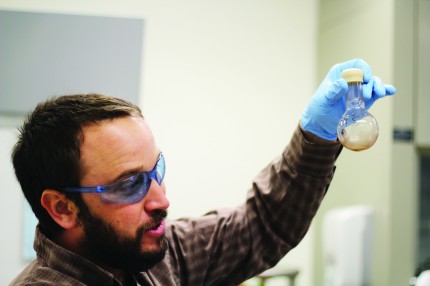School of Hard Science – The Gold Standard: Potential energy applications for new gold complex
February 3, 2014 9:11 pm Leave your thoughtsPhoto by Nick Weems
Pulling a round-bottom flask from the freezer in one of Wubben Hall’s chemistry labs, Dr. David Weinberg looks excited, and he should. While the beaker is anything but full, at the bottom, in a shallow pool of clear liquid, lies a sprinkling of gold-colored shards that represent the last few years of work for the CMU chemistry professor and his student researchers.
The crystalline shards actually are gold—gold complexes to be exact—and play a key role in the big-picture idea of being able to convert methane, a gas, into liquid methanol.
“This is a new gold complex that has not been made outside of our research group,” Weinberg said of the substance in the flask. “We make new gold complexes that no one else has ever made before, and then we look at their chemistry.”
So what does gold have to with energy conversion? In the case of Dr. Weinberg’s research, gold acts as the catalyst that allows carbon-hydrogen bonds to be converted into either carbon-oxygen or carbon-nitrogen bonds.
“The reason we’re interested in this is that natural gas and oil, which is where we get the vast majority of our chemicals and will do so for the foreseeable future, are composed mainly of carbon-carbon bonds and carbon-hydrogen bonds,” Weinberg said. “So if we want to convert them into other things, we need ways to manipulate those bonds, particularly natural gas, which is mostly methane.”
Simply put (although the process is anything but simple), the atomic structures of these lab-created gold complexes should allow for a veritable rearranging and sharing of electrons, which in turn breaks the carbon-hydrogen bonds.
Though Weinberg and his team have yet to create a complex capable of fully breaking these bonds, the possible implications of their work are far-reaching.
“The inspiration behind this was about our natural gas sources in the US,” Daniel Ohlson, a senior chemistry major who worked under Dr. Weinberg last year, said. “Natural gas is mostly methane… Unfortunately, it’s a gas, and in order to transport and store it, it’s really complicated. Transporting it is problematic.”
One solution for storage and transportation is to convert high-volume methane gas into a lower-volume liquid like methanol. Currently, converting methane into other products is a laborious process that requires high temperatures and plenty of energy.
“You lose a lot of heat in that process, so being able to do it in just one step would be ideal,” Weinberg said. “So that’s what we’re looking at, being able to convert carbon-hydrogen bonds to other bonds in one step. And for that, we look at using gold complexes.”
In addition to Dr. Weinberg’s research on gold catalysts for methane conversion, he is also looking at existing research regarding the idea of storing solar energy in chemical bonds, another endeavor that would require certain bond-breaking catalysts.
“Chemical bonds, once you make them, are very stable, and then you can simply burn them in order to get the energy out of them,” Weinberg said. “So it’d be like making gasoline out of sunlight.”
Like chemists in a number of places across the country, Weinberg is researching non-gold catalysts that would make possible the conversion of solar-generated electricity into usable, easy-to-store fuels.
“People don’t have a good idea right now of what the limitations are or how to design new catalysts. It’s a hot topic, people want to be able to do it, but it’s very challenging.”
cblackme@mavs.coloradomesa.edu
Tags: chemistry, Colorado Mesa University, Dr. David Weinberg, Gold complexes, science, Special SectionCategorised in: Features
This post was written by critedev

